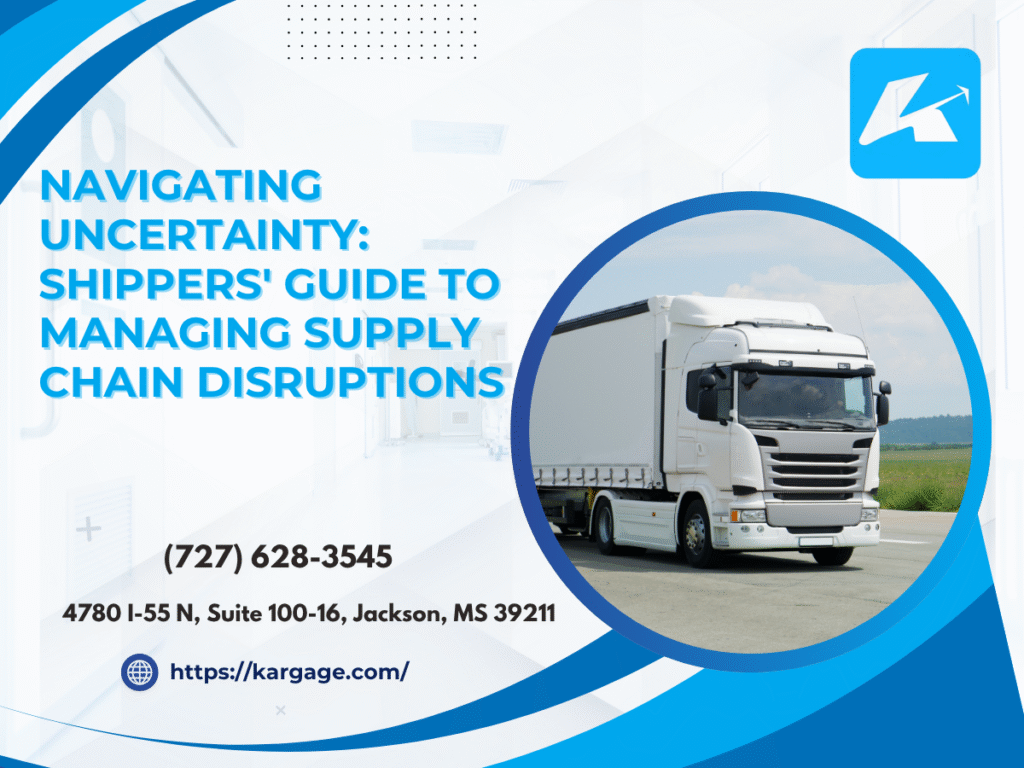In today’s fast-paced world, supply chains are like tightropes—one gust of wind, and everything wobbles. From port congestion to natural disasters, disruptions can derail even the best-laid shipping plans. For shippers, managing these uncertainties is critical to keeping goods moving and customers happy.
How do you stay steady when the unexpected hits?
This guide offers five practical strategies to help shippers navigate supply chain disruptions with confidence and keep logistics on track.

1. Build a Resilient Supply Chain Plan
A solid plan is your first defense against disruptions. Start by mapping your supply chain—identify suppliers, carriers, and key routes. Then, pinpoint risks, like reliance on a single port or supplier.
Diversify where possible: source from multiple vendors or use alternate routes. For example, if a West Coast port is congested, consider East Coast options. Build buffers, like extra inventory or flexible timelines, to absorb shocks.
Resilience means preparing for the worst while hoping for the best.
Pro Tip: Conduct a quarterly risk assessment. Update your plan to reflect new threats, like trade policy changes or weather patterns.
2. Leverage Real-Time Data and Technology
When disruptions strike, knowledge is power. Technology like Transportation Management Systems (TMS) and real-time tracking tools gives you visibility into your supply chain.
A TMS can flag delays—say, a truck stuck in traffic—and suggest reroutes. IoT sensors on refrigerated cargo can alert you to temperature spikes. Cloud-based platforms let you share data with carriers and suppliers instantly, speeding up decisions.
Companies like Kargage, based in Jackson, Mississippi, use tech to help shippers monitor shipments and pivot during disruptions.
Action Step: Invest in a TMS or tracking app. Ensure your logistics partners offer real-time updates to stay ahead of issues.
3. Strengthen Carrier and Supplier Relationships
Disruptions test partnerships, but strong relationships can weather the storm. Regular communication with carriers and suppliers builds trust and flexibility when things go sideways.
For instance, a reliable carrier might prioritize your load during a capacity crunch if you’ve built rapport. Suppliers who know your needs can adjust production or delivery schedules during shortages.
Open dialogue—sharing forecasts or challenges—creates a team effort. Kargage, with its network of over 25,000 carriers, helps shippers forge these bonds for smoother logistics.
Quick Tip: Schedule monthly check-ins with key partners. Discuss potential risks and backup plans to align strategies.
4. Plan for Contingencies
You can’t predict every disruption, but you can prepare for them. Develop contingency plans for common issues like port strikes, fuel spikes, or weather events.
For example, if a hurricane threatens Gulf Coast ports, have alternate routes or modes (like rail) ready. Stockpile critical goods to cover delays, especially for time-sensitive cargo like perishables. Cross-train staff to handle unexpected tasks if labor shortages hit.
Contingency planning turns chaos into manageable hiccups.
Best Practice: Create a disruption playbook. List scenarios, solutions, and contacts (carriers, brokers, suppliers) for quick action.
5. Stay Agile and Adaptable
Disruptions demand flexibility. Shippers who adapt quickly—whether by rerouting cargo, adjusting delivery schedules, or renegotiating contracts—stay ahead.
Monitor global trends, like trade tariffs or geopolitical shifts, to anticipate impacts. For instance, recent port delays on the East Coast pushed shippers to explore Mexican routes. Stay in touch with industry news through sources like FreightWaves or the Journal of Commerce.
Agility means turning challenges into opportunities, keeping your supply chain moving.
How to Start: Set up a weekly news digest for your team. Use insights to tweak plans and stay ready for sudden changes.

Putting It All Together
Supply chain disruptions are inevitable, but they don’t have to derail your business. By building a resilient plan, leveraging technology, strengthening partnerships, planning contingencies, and staying agile, shippers can navigate uncertainty with ease.
These strategies aren’t just about survival—they’re about thriving in a unpredictable world. At Kargage, we’ve seen how proactive shippers keep cargo flowing, no matter the challenge. But this isn’t about us—it’s about you.
Need a partner to weather the storm? Call us at (727) 628-3545 for a quote. With this guide, you’re ready to steer your supply chain through any disruption.

